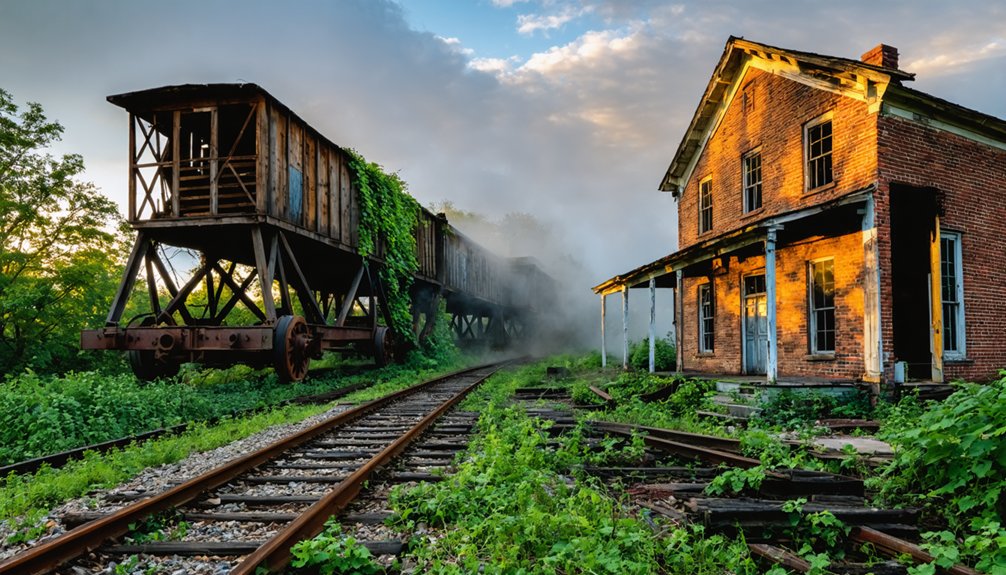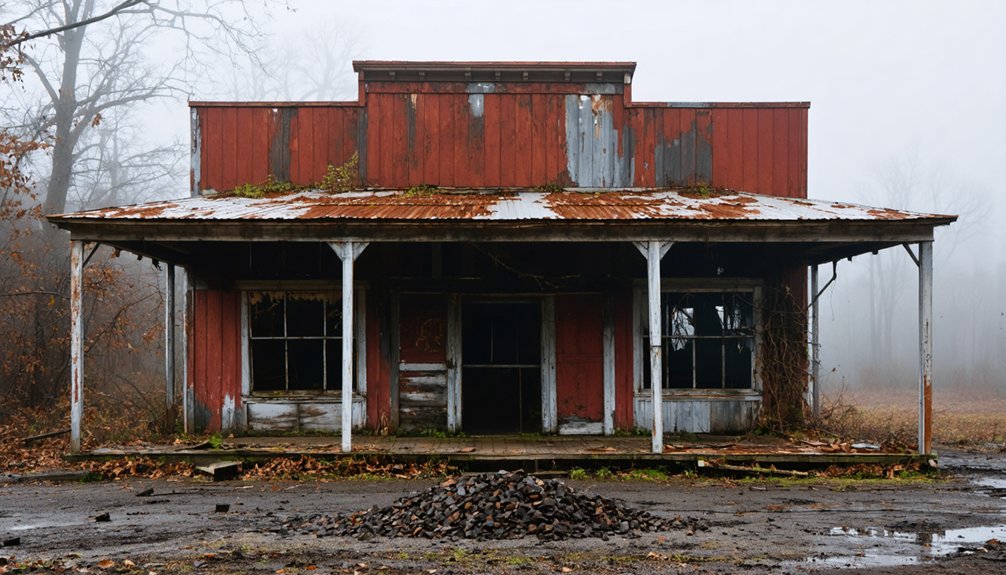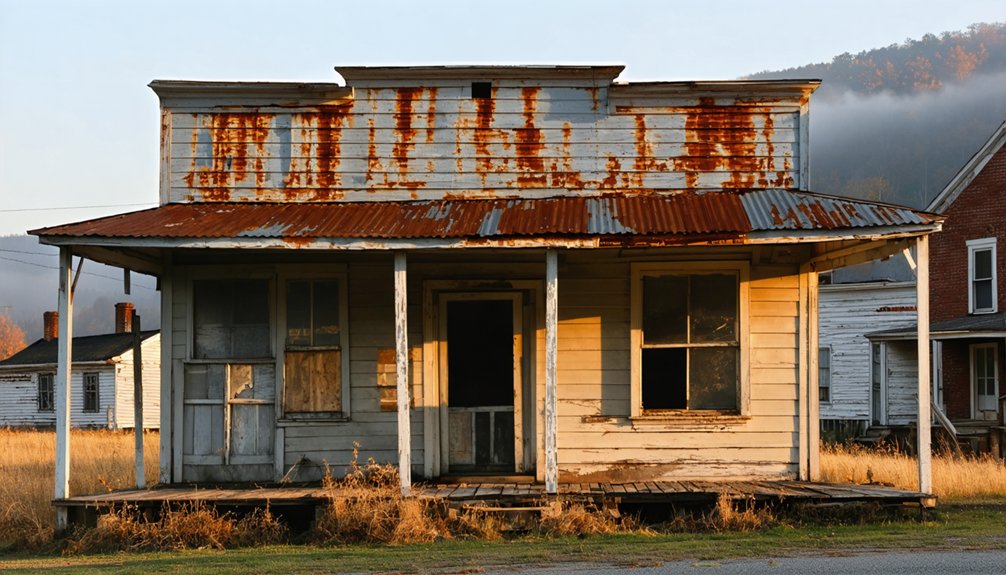You’ll find Packard nestled in Kentucky’s Cumberland Mountains, where it emerged as a thriving coal mining town around 1900. At its peak, this company town housed 400 residents and employed 250 workers through the Mahan Jellico Coal Company, complete with its own stores, schools, and railway station. By the mid-1940s, depleted coal seams forced families to abandon their homes, leaving behind crumbling buildings and rusty rail tracks that tell stories of a once-bustling Appalachian community.
Key Takeaways
- Packard was a bustling Kentucky coal mining town established in 1900, named after schoolteacher Mary Amelia Packard.
- At its peak, the town supported 400 residents and employed 250 workers across three coal mining operations.
- The community featured company-owned houses, a company store, schools, churches, and relied heavily on mining-based scrip currency.
- Economic decline began in the mid-1940s when coal seams thinned, leading to mass exodus and eventual abandonment.
- Today, Packard exists as a ghost town with deteriorating wooden buildings, abandoned rail tracks, and mining remnants behind “No Trespassing” signs.
The Rise of a Kentucky Coal Mining Community
As the nineteenth century drew to a close, a small mining camp emerged in the Cumberland Mountains that would soon become the bustling community of Packard, Kentucky. Founded by the Thomas B. Mahan family around 1900, this settlement quickly transformed from a remote outpost into a essential coal mining hub, named after local schoolteacher Mary Amelia Packard.
You’ll find the community’s historical significance deeply rooted in its three coal operations, with the Mahan Jellico Coal Company leading the charge. The company’s influence extended through its company store tokens, which workers used instead of U.S. currency to purchase goods. Workers often faced forced poverty due to inflated prices at company stores.
The town’s community dynamics revolved entirely around mining life, as up to 250 workers and their families called Packard home. With the arrival of the Louisville and Nashville Railroad and the establishment of a post office in 1908, you’d have witnessed Packard’s evolution from a simple camp into a proper coal town.
Life in the Company Town
When you stepped into Packard during its heyday, you’d find yourself immersed in a quintessential company town where every aspect of life centered around the coal mines.
The community dynamics revolved around shared spaces – schools, churches, and the all-important company store. National Guardsmen had to be deployed to maintain the peace during wage disputes.
But beneath the surface of this close-knit community lay a system of economic dependency that kept miners tethered to their work. Mahan Jellico Coal Company was the largest employer, providing jobs to over 200 workers in the area.
You’d witness miners receiving their pay in scrip instead of dollars, forcing them to shop at the overpriced company store.
This practice made it nearly impossible to save money or seek opportunities elsewhere.
While the town’s population of 400 might’ve seemed like a thriving community, they were bound together not just by choice, but by necessity under the coal companies’ control.
Mining Operations and Economic Impact
Though miners worked with rudimentary tools and equipment in Packard’s coal operations, they managed to extract significant quantities of coal that supported three separate mining companies.
You’d find workers spending long days underground using picks, shovels, and primitive mechanized equipment, earning their wages in company scrip rather than U.S. dollars.
While exact production figures aren’t recorded, the mines employed up to 250 workers at their peak, suggesting these were substantial operations for a small Appalachian coal town. Today, only old stone stairs and foundations remain as silent reminders of this once-bustling mining community.
The Packard Coal Company was the primary mining operation in the area, with its convenient access to the Louisville and Nashville Railroad for coal transport.
Mining Equipment and Technology
During the early 20th century, Packard’s coal mining operations embraced the era’s cutting-edge technology, from Joy 32″ shuttle cars to mechanized conveyor systems. The Smithsonian’s collection provides vital documentation of these technological advances.
You’d find mining innovations transforming the landscape as companies invested in mechanized extraction methods to boost efficiency and production. The implementation of mule-free transportation marked a significant shift toward modernization.
The evolution of mining technology in Packard included:
- Electric-powered shuttle cars that could navigate tight underground spaces
- Automated conveyor belt systems for efficient coal transport
- Motor trucks, including the namesake “Packard” model, for surface hauling
- Electric locomotives and cutting machines for enhanced extraction
These advancements helped sustain the town’s peak operations, employing up to 250 workers before World War II.
While the technology improved production, you’ll note it also reduced the need for manual labor, contributing to the eventual shifts in Packard’s mining workforce.
Worker Life and Pay
Behind the advanced machinery and technological progress of Packard’s mines lay a more complex reality of daily worker life.
The Elite Coal Company and other regional operators built coal camp communities throughout Kentucky’s mining districts. You’d find miners trapped in a system of economic exploitation, where the Mahan Jellico Coal Company controlled nearly every aspect of their existence. They’d receive payment in company scrip instead of real cash, forcing them to shop at overpriced company stores while accumulating debt.
Worker struggles defined life in this company town, where over 200 employees faced dangerous working conditions and meager wages. Between 1880 and 1923, over 70,000 miners lost their lives in workplace accidents across America’s coalfields.
You couldn’t escape the cycle easily – the company owned your housing, controlled your shopping, and limited your options.
During labor disputes, including the dramatic 1922 United Mine Workers Strike, miners risked everything to fight for better conditions, sometimes facing National Guard intervention.
Coal Production Statistics
While exact production figures remain elusive, Packard’s coal operations carved out a significant footprint in eastern Kentucky’s mining landscape from the late 19th century through 1946.
You’ll find that three companies, led by the Mahan Jellico Coal Company, drove the town’s coal extraction efforts during its productive years.
Key statistics about Packard’s mine productivity include:
- Peak workforce of 250 miners across all three operations
- Population reached nearly 400 residents at height of mining activity
- Mahan Jellico employed up to 200 workers as the dominant producer
- Operations sustained continuous production for over 50 years
Though smaller than major regional producers like Pike County’s 35-million-ton annual operations, Packard’s mines maintained steady output until mechanization and resource depletion led to their closure in 1946.
Notable Figures and Cultural Heritage

Although Packard’s buildings have vanished into Kentucky’s landscape, the town’s most celebrated legacy lives on through Oscar-winning actress Patricia Neal, who was born there in 1926.
Beyond Neal’s cultural legacy, you’ll find the town’s history preserved through the stories of Mary Amelia Packard, the local schoolteacher for whom the town was named, and Thomas B. Mahan, whose coal company established the original mining camp around 1900.
The town’s cultural fabric was woven around its railway station, post office, and company commissary, where miners gathered after long days in the mines.
While these structures no longer stand, their foundations remain as silent witnesses to Packard’s past.
Today, oral histories and scattered photographs are all that preserve the memory of this once-bustling coal town.
Daily Life and Social Structure
In the isolated hills of Kentucky, Packard’s daily rhythms were dictated by the coal mines that employed up to 200 workers at their peak.
The community dynamics revolved entirely around the mining operations, with social interactions centered at the company store and school building.
Life in Packard was marked by these key aspects:
- You’d find most residents living in company-owned houses, creating tight-knit neighborhoods.
- Your wages would come in company scrip, limiting your purchasing power to the local store.
- You’d see children attending the town’s single school, while adults worked mine shifts.
- You’d experience a strong sense of community born from shared struggles and isolation.
The economic control exercised through scrip payments often led to tensions, occasionally requiring National Guard intervention to maintain order.
The Decline and Abandonment

Once the coal seams began thinning in the mid-1940s, Packard’s fate was sealed. The town’s economic fragility became painfully apparent as the Mahan Jellico, Polley, and Booth Blue Gem coal companies struggled to maintain operations.
With coal resources depleting, employment plummeted from 250 workers to nearly zero, triggering a mass exodus of families seeking opportunities elsewhere.
Years of social unrest had already strained the community, particularly due to the restrictive scrip payment system that kept miners bound to company stores.
You can trace how the town’s decline accelerated through its physical deterioration – worker housing fell into disrepair, company stores shuttered, and infrastructure crumbled.
Today, nature has reclaimed most of Packard, leaving only scattered ruins and foundations as evidence of its mining past.
What Remains Today
Today, you’ll find Packard’s remaining structures hidden behind “No Trespassing” signs on private property, where nature steadily reclaims what was once a bustling mining town.
The physical remnants tell a story of Kentucky’s coal heritage, though accessing these historical structures requires permission from current landowners.
Thick vegetation and weathering continue to erode the few surviving buildings, slowly erasing the visible traces of this once-thriving community of 400 residents.
Physical Structures Today
While time has steadily erased much of Packard’s physical presence, several dilapidated wooden-frame houses and industrial remnants still dot the Kentucky landscape.
You’ll find these early 20th-century structures primarily on private property, where harsh weather and neglect have taken their toll. The mining infrastructure tells a story of industrial decline through its:
- Crumbling foundations of former tipples and loading zones
- Abandoned rail tracks that once carried coal shipments
- Skeletal remains of the company commissary building
- Scattered machinery artifacts hidden beneath overgrown vegetation
The town’s public buildings haven’t fared any better – the school and other community facilities have largely vanished, with only fragments remaining to hint at Packard’s once-bustling past.
Without preservation efforts, these last physical connections to the town’s mining heritage continue to fade.
Nature Reclaims Mining Town
Nature’s persistent march has transformed Packard’s landscape into an almost unrecognizable wilderness. If you visit today, you’ll find dense forest where streets once ran, as ecological succession has steadily erased the town’s industrial past.
Kudzu, an aggressive invasive species, blankets old foundations and remnants, making it nearly impossible to spot man-made features without a local guide.
The mining ponds that once served the community have softened into natural-looking water features, now home to native wildlife. You’ll notice how tree roots have cracked through concrete, and pioneer species have colonized every available space.
Even the railroad bed, one of Packard’s last visible human imprints, is gradually disappearing beneath nature’s determined advance. What was once a bustling coal town has become a reflection of nature’s reclamation power.
Preserving Packard’s Memory

Despite the physical disappearance of Packard, Kentucky, dedicated efforts to preserve its memory persist through various channels.
Local oral histories and digital preservation initiatives have become essential in keeping the town’s legacy alive for future generations.
You’ll find Packard’s story preserved through:
- Extensive documentation of former residents’ memories, detailing daily life in this once-thriving coal community of 400 people
- Digital archives featuring rare photographs, company scrip tokens, and remnants of mining structures
- Online repositories and YouTube documentaries that showcase historical commentary and period artifacts
- Community contributions to heritage groups that maintain collections of stories, images, and memorabilia
While only two known photographs remain, the combined efforts of historians, collectors, and former residents guarantee that Packard’s history won’t fade into obscurity.
Frequently Asked Questions
Were There Any Major Mining Accidents or Disasters in Packard’s History?
Like a dark cloud over history, you won’t find detailed mining safety records or accident reports from Packard’s past, though small-scale incidents likely occurred during its coal-mining operations.
What Happened to the Mining Equipment When the Town Was Abandoned?
You won’t find clear records about equipment relocation from Packard’s mines. Despite efforts toward historical preservation, no documentation exists detailing what happened to the machinery when operations ceased.
Did Any Other Industries Besides Coal Mining Exist in Packard?
You won’t find evidence of timber industry or agriculture practices in this town. Coal mining dominated completely, with the company store and scrip system preventing other industries from taking root.
Were There Any Known Ghost Stories or Legends About Packard?
You won’t find documented ghost stories or haunted history from Packard’s past, though local folklore might exist. The remote, abandoned mining town’s ruins leave much to your imagination.
How Did Residents Get Their Medical Care in the Isolated Town?
You’d face an incredibly tough situation with zero medical facilities nearby. You’d rely heavily on home remedies, community support, and rare visits from traveling doctors for healthcare access.
References
- https://www.novanumismatics.com/the-elusive-story-of-packard-kentucky-and-its-tokens/
- https://www.frrandp.com/2018/07/packard-kentucky-another-abandoned-coal.html
- https://www.youtube.com/watch?v=dMYY-gEGkEM
- https://www.freakyfoottours.com/us/kentucky/
- https://www.youtube.com/watch?v=MD9nGcsxHAY
- https://pantheon.world/profile/place/packard-kentucky
- https://en.wikipedia.org/wiki/Packard
- http://www.coaleducation.org/coalhistory/coaltowns/coalcamps/whitley_county.htm
- https://www.coinbooks.org/esylum_v14n50a11.html
- http://www.coaleducation.org/coalhistory/tech2/e10.htm



